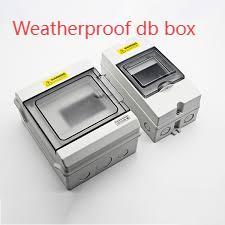Specifying the right enclosure can mean the difference between uninterrupted operations and repeated service calls, and choosing a rugged Weatherproof db box early in project planning directs safer siting, easier maintenance, and fewer electrical failures under adverse weather. This article explores how enclosure design, installation detail, and maintenance practice combine to keep control systems functioning in wet, dusty, or sun-exposed settings.
Why enclosure selection matters
An electrical distribution box is more than a container: it defines how circuits are protected, how technicians access components, and how quickly a fault can be diagnosed. Selecting an enclosure without considering ingress protection, thermal behavior, and mounting constraints often leads to corrosion, short circuits, or connector failures. Properly specified boxes reduce unplanned downtime and shorten repair cycles, especially where exposures are frequent and maintenance windows limited.
Materials, seals, and construction features
Material choice matters. UV-stable polymers, powder-coated metals, and corrosion-resistant alloys survive outdoor exposure much longer than untreated alternatives. Equally important are sealing systems: long-life gaskets, captive hardware, and reinforced hinge assemblies prevent water and dust ingress through repeated openings. Thoughtful internal design—such as raised mounting plates, drip channels, and cable entry knockouts—keeps critical connections isolated from contaminant pathways and simplifies service without compromising the protective barrier.
Ingress protection and thermal management
Ingress ratings give useful guidance but must be interpreted in context. An IP66 rating protects against strong jets of water and dust, whereas higher or lower ratings may be appropriate depending on washdown frequency, airborne contamination, or submersion risk. Thermal management is another common oversight: densely packed components generate heat that can speed seal degradation or reduce breaker performance. Passive vents with insect screens, thermal gaps, or modest internal circulation are simple measures that protect internal components while maintaining protection from the elements.
Mounting, placement, and mechanical protection
Where a box is mounted changes its exposure profile. Positioning above drip lines, avoiding splash zones, and situating units out of direct runoff paths prevent chronic moisture contact. Mechanical protection—such as bollards in traffic zones or guarded recesses near equipment—prevents knocks that can crack housings or deform seals. Secure anchoring and anti-vibration mounts reduce stress on terminations and gland seals, particularly near vibrating machinery or doors subject to frequent opening.
Installation practices that reduce failure modes
Correct conduit entry, properly sized cable glands, and strain relief minimize stress on terminations and preserve sealing integrity. Use correct torque values for terminal screws to prevent hot spots, and respect bend radii to avoid conductor fatigue. Where multiple trades connect equipment, establish handover testing and documentation so every installation is verified against the same checklist—continuity, insulation resistance, and earth-bond tests all create a useful baseline for future troubleshooting.
Serviceability and spare-part planning
Designing for serviceability pays dividends. Removable interior plates, modular terminal blocks, and externally accessible fuses reduce the time required for routine work. Standardizing on common gasket sizes, fasteners, and gland types across multiple boxes simplifies spare-part inventories and shortens repair times. Consider specifying spares and a simple field kit for technicians so routine fixes don’t require special-order parts that delay repairs.
Maintenance regimes and inspection cadence
An effective maintenance plan blends regular visual inspections with periodic electrical tests. Look for early signs of degradation: gasket compression, corrosion on terminals, or discoloration of insulating components. Schedule checks before known high-risk periods—monsoon or freeze seasons, for example—to catch emerging issues. Thermal imaging during load conditions highlights hotspots, while simple drip tests or spray checks verify ongoing ingress protection without dismantling the unit.
Compliance, labeling, and training
Regulatory compliance reduces liability and enhances safety. Ensure enclosures and installed components meet applicable standards for the intended use, and label circuits and isolation points clearly to speed safe shutdowns. Training front-line staff in basic diagnostics and safe isolation prevents accidental energizing during maintenance and builds a culture of careful operation that reduces risky improvisations.
Lifecycle thinking and total cost of ownership
A higher initial investment in a rugged, well-designed box is often justified by lower lifecycle costs: fewer service calls, reduced component replacement, and less production interruption. Evaluate total cost of ownership—installation time, maintenance labor, spare parts, and expected service life—rather than comparing only purchase price. Modular, repair-friendly designs tend to deliver better returns over years of service.
Conclusion: practical priorities for resilient installations
Robust distribution enclosures protect people and production when selected and installed with attention to materials, sealing, thermal behavior, and serviceability. Prioritize realistic ingress ratings, plan mounting and mechanical protection carefully, and build a spare-parts and maintenance plan that minimizes downtime. Thoughtful specification and consistent maintenance create resilient power systems in outdoor and harsh environments. For product specifications, accessories, and compatibility options, visit www.nante.com/product/

